Architectural Series—Surfaces



Wood Veneers
Wood veneer is a natural material that provides beauty, warmth and, most of all, variety. Each piece is unique, with nature producing individual shapes and colors within the same tree. A great choice for classic or modern design, Oregon Door provides any commercially available wood veneer, including various species: birch, maple, oak, cherry, walnut, mahogany, and more.
Wood veneers are available in multiple grades, matches, and assemblies to meet design requirements, including domestic and exotic selections. Common veneer cutting methods include plain sliced or flat cut, quarter sliced, rift cut, and rotary.
1. Window & Door Manufacturers Association (WDMA I.S. 1-A)
2. Architectural Woodwork Standards (AWS) Quality Standards, sections 5 and 9
WDMA is the industry standard for door manufacturers, while AWS is more commonly used in specialty installations requiring doors to be blueprint matched with wall paneling and/or to blend with adjacent millwork. In most instances, WDMA requirements are most appropriate to assure consistent appearance amongst doors as usually architectural and commercial doors are not directly associated with panels or millwork.
AWS and WDMA set two aesthetic grades for architectural wood doors: custom and premium. Custom is the standard grade intended for high-quality work. This grade provides a well-defined degree of control over the workmanship, materials, and installation of a project.
Most Craftsman Series doors are premium grade. This grade is reserved for special projects or featured areas within a project. Premium grade doors are specified when the highest degree of control is required.
The difference between a custom and premium grade doors is the stile construction, veneer grade – adopted from HPVA panel veneer grading tables – and veneer assembly. Below is a simple comparison of the two grades:

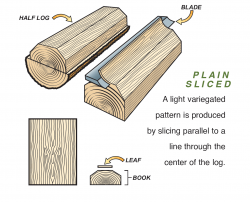 boards are cut, just in much thinner layers. The veneer slices, or leaves, are kept in the same order in which they are cut and then reassembled with only a very gradual grain figure transition from one panel to another. The result is a veneer that looks like multiple boards, each with the typical arched or “cathedral” pattern in the grain that comes from cutting parallel to the growth rings.
boards are cut, just in much thinner layers. The veneer slices, or leaves, are kept in the same order in which they are cut and then reassembled with only a very gradual grain figure transition from one panel to another. The result is a veneer that looks like multiple boards, each with the typical arched or “cathedral” pattern in the grain that comes from cutting parallel to the growth rings.
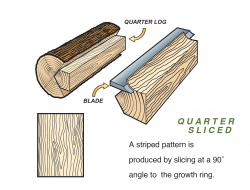 that the growth rings are perpendicular to the cutting blade. Quartered leaves are cut consecutively, are narrower than plain sliced, and are easily matched. This cut requires the largest diameter of logs. Quarter sliced oak is often sliced specifically for its appearance of a distinct flake marking – which is actually created by the veneer knife bisecting prominent radial patterns in the tree, called medullary rays.
that the growth rings are perpendicular to the cutting blade. Quartered leaves are cut consecutively, are narrower than plain sliced, and are easily matched. This cut requires the largest diameter of logs. Quarter sliced oak is often sliced specifically for its appearance of a distinct flake marking – which is actually created by the veneer knife bisecting prominent radial patterns in the tree, called medullary rays.
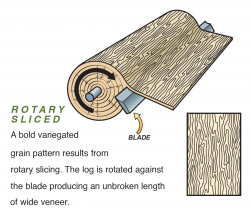 Think of a roll of paper towels, and you get the idea. This is the least-expensive way to produce the veneer, and it can often be laid in one big sheet. Rotary-cut veneer has wild, random grain patterns.
Think of a roll of paper towels, and you get the idea. This is the least-expensive way to produce the veneer, and it can often be laid in one big sheet. Rotary-cut veneer has wild, random grain patterns.
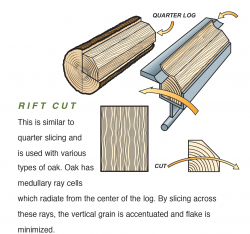 the slices are more perpendicular to the growth rings. Just like with the plain-sliced, the slices get laid out side by side, but the grain pattern shows up as fairly straight lines instead of as a repeating arches. You may even have to examine the veneer sheet closely to tell where the individual veneer slices begin and end. Only used with various types of oak, rift cut slices across the medullary ray cells to accentuate the vertical grain while minimizing flake. You should expect to pay more of a premium price for rift cut veneer because the process is more involved and creates more waste.
the slices are more perpendicular to the growth rings. Just like with the plain-sliced, the slices get laid out side by side, but the grain pattern shows up as fairly straight lines instead of as a repeating arches. You may even have to examine the veneer sheet closely to tell where the individual veneer slices begin and end. Only used with various types of oak, rift cut slices across the medullary ray cells to accentuate the vertical grain while minimizing flake. You should expect to pay more of a premium price for rift cut veneer because the process is more involved and creates more waste.Once the decorative veneer cutting method is specified, the type of match at the joint line must be specified. The way in which the individual cuts are placed next to each other during the fabrication of the veneer face affects the appearance of the doors.
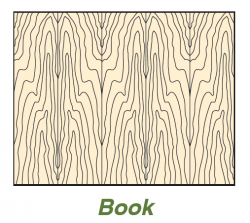
Thus the grain is mirrored in each adjacent leaf. The visual effect created is that veneer joints match, creating a symmetrical pattern. This type of matching yields maximum continuity of grain. When sequenced panels are specified, prominent characteristics will “ascend” or “descend” across the match as the leaves progress from panel to panel.
Book matching may be used with plain, quarter or rift sliced veneers. Because the “tight” and “loose” faces alternate in adjacent leaves, they reflect light and accept stain differently. This may yield a noticeable color variation, often called barber pole, in some species or flitches. These variations are not considered a manufacturing defect.
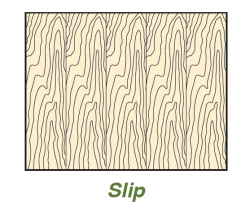 the same face sides being exposed. The visual effect shows a grain figure repeating, but joints do not show grain match.The lack of grain match at the joints with slip matching can be desirable. The relatively straight grain patterns of quartered and rift veneer generally produce pleasing results and a uniformity of color because all faces have the same light refraction. This is in contrast to book matching where alternating leaves are turned over.
the same face sides being exposed. The visual effect shows a grain figure repeating, but joints do not show grain match.The lack of grain match at the joints with slip matching can be desirable. The relatively straight grain patterns of quartered and rift veneer generally produce pleasing results and a uniformity of color because all faces have the same light refraction. This is in contrast to book matching where alternating leaves are turned over.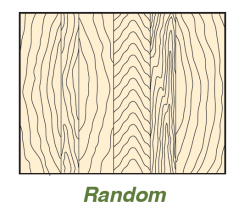 orientation and randomly spliced edge to edge, producing a “board-by-board” effect in many species. This produces a casual or rustic appearance, as though individual boards from a random pile were applied to the product. Conscious effort is made to mismatch grain at joints.
orientation and randomly spliced edge to edge, producing a “board-by-board” effect in many species. This produces a casual or rustic appearance, as though individual boards from a random pile were applied to the product. Conscious effort is made to mismatch grain at joints.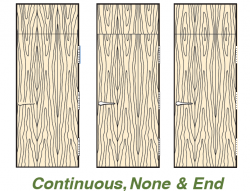
The type of “assembly match,“ must be specified to obtain a desired appearance. Any sequence matching from opening to opening must be specified.
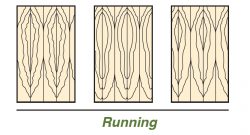 Veneer pieces of unequal width are common. Each face is assembled from as many veneer pieces as necessary.
Veneer pieces of unequal width are common. Each face is assembled from as many veneer pieces as necessary.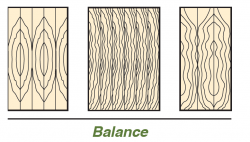 odd number of pieces of uniform width before trimming. This match reduces veneer yield.
odd number of pieces of uniform width before trimming. This match reduces veneer yield.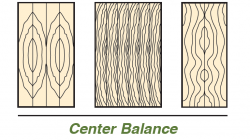 veneer joint in the center of the panel. This match further reduces veneer yield.
veneer joint in the center of the panel. This match further reduces veneer yield.Wood is a product of nature; as such, each wood species has certain intrinsic and industry-acceptable characteristics, which can vary from tree to tree and flitch to flitch. Natural variations of the veneer and different cuts create unique textures, grains, figure, and color for each veneer piece and door.
In some cases, wood will accentuate and enhance a project design when used in its purest, or natural, state. These naturally occurring variations provide richness and uniqueness to each project design. All wood species can vary from flitch to flitch., and environmental factors such as climate and soil content can make each veneer species exhibit a range of colors and textures.
Certain wood species, such as natural maple and birch, can vary widely in color range. When specifying “natural” maple and birch, the veneer will contain unlimited amounts of sapwood (the light portion of the log) and/or heartwood (the dark portion of the log) unselected for color. They may contain many sapwood/ heartwood combinations, color streaks, spots, and color variation from almost white to very dark. To avoid these noticeable color and grain variations, select veneers must be specified. If a light colored veneer is preferred, specify select white (all sapwood) maple or birch. If a dark colored veneer is preferred, specify select red/brown (all heartwood), though availability of this selection may be limited.
View Our Factory Finishing/Color Samples Here
Plastic laminate doors offers a limitless creative license for your design interior with a resilient and strong material. Choose from solid colors or patterns to achieve a unique or bold statement. Or choose a wood grain material to achieve consistency in appearance from door to door.
This is the right choice when uniformity and heavy use applications are required. Plastic laminate is extremely tough, holding up to daily bumps and scratches. Plus, being less porous than veneer, this surface is easier to clean. Imagine every door you spec matching exact grain and color and holding up to years of wear and tear.
High-pressure decorative laminate (HPDL) is the direct descendent of the original plastic laminate. It is considered to be one of the most durable decorative surface materials and is available with special performance properties including chemical, fire and wear resistance. For doors, it is often specified when uniformity in the surface material is essential so doors present a consistent appearance in each opening.
Extremely durable, HPDL doors offer many design options when compared to wood veneer: custom designs in many patterns, wood grain, and solid colors. Easy-to-install HPDL doors don’t need to be painted, stained, or sealed on-site. And in general, HPDL faces are consistent, affordable, and incur minimal maintenance costs.
HPDL is produced by saturating multiple layers of kraft paper with phenolic resin. A layer of printed décor paper is placed on top of the kraft paper before pressing. The resulting sandwich is fused together under heat and pressure (more than 1,000 PSI).
Because phenolic and melamine resins are thermoset plastics, the curing process transforms the resin into plastic by a cross linking process that converts the paper sheets into a single, rigid laminated sheet. Thermosetting creates strong, irreversible bonds that contribute to HPDL’s durability.
The number of patterns, colors, and designs available are practically limitless. Oregon Door works with all major US laminate manufacturers. Explore many of the options from the following manufacturers:
Paintable Surfaces
Need to match an interior paint, carpet or fabric to create that perfect color scheme? Oregon Door’s paintable surface doors offer complete versatility to enhance or complement any interior design theme. complement the interior design. Choose from three surface options: birch, hardboard or medium density overlay (MDO).
Both MDO and hardboard provide uniform surfaces, so you’ll have no worries about knots, raised grain, or other flaws. Doors are available pre-primed, reducing on-site sanding or priming.